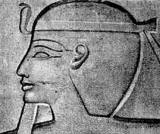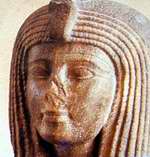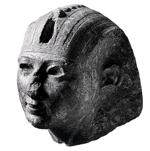| 22nd Dynasty (194) 945-751BC | |
| Dating of this dynasty, as well as the whole III IP, proposed by Prof. K.Kitchen seems to be the most reliable, although in light of D.A. Aston analyses, not completely convincing. Generally the IX century BC is one of the less studied of all periods of Egyptian history. It seems to me that the recent state of knowledge, supported by dubious, often contradictory records, makes the precise presentation of political history of the III Intermediate Period impossible. The reason for free interpretation of facts is among other the partition of rule among a few, more or less, powerful political centers. Potent role play Thebes with the office of High Priest of Amun, held by high priests related to rulers of the dynasty XXII and often aspiring to rule all over the land. Also in areas of Herakleopolis and Hermopolis in the Central Egypt there are princes holding independent rule and they happen to be nominated by legitimate pharaohs from Delta. | |
|
Shoshenk I |
|
 Governor
of Bubastis descending from Libyan immigrants. The son of Nimlot and
Tanetsepeh, he overtook the rule after Psusennes II death. He was
energetic ruler who held control with support of army. He settled
Nimlot, one of his sons, at Herakleopolis to hold rule over Central
Egypt in his behalf. Later he made his second son, Iuput, the
high priest of Amun at Thebes, what actually meant re-unifying of
the land. His daughter, Tashepenbastet was married to the third
prophet of Amun at Thebes. Also for other influential offices all
over the land were nominated loyal to Sheshonq people, which
efficiently removed eventual threat for royal power. He made war
expeditions to Syria and Palestine, conquered Jerusalem and some
other cities in 925 BC. Asiatic expedition of Sheshonq is object of
few speculations among modern historians and “parahistorians” that
hold Bible as the main source of information and thus warp
completely history and chronology of ancient Egypt. Building
activities during Sheshonq I rule focused mainly at Thebes, Memphis
and in the Delta - at Bubastis, Tanis, Tell Ballala. Governor
of Bubastis descending from Libyan immigrants. The son of Nimlot and
Tanetsepeh, he overtook the rule after Psusennes II death. He was
energetic ruler who held control with support of army. He settled
Nimlot, one of his sons, at Herakleopolis to hold rule over Central
Egypt in his behalf. Later he made his second son, Iuput, the
high priest of Amun at Thebes, what actually meant re-unifying of
the land. His daughter, Tashepenbastet was married to the third
prophet of Amun at Thebes. Also for other influential offices all
over the land were nominated loyal to Sheshonq people, which
efficiently removed eventual threat for royal power. He made war
expeditions to Syria and Palestine, conquered Jerusalem and some
other cities in 925 BC. Asiatic expedition of Sheshonq is object of
few speculations among modern historians and “parahistorians” that
hold Bible as the main source of information and thus warp
completely history and chronology of ancient Egypt. Building
activities during Sheshonq I rule focused mainly at Thebes, Memphis
and in the Delta - at Bubastis, Tanis, Tell Ballala.Other Datings 948-927
(Dodson) |
|
|
Osorkon I |
|
 Son
of Takelot by queen Kapes, father of high priest Nimlot (II) and of
king Takelot II. Osorkon built mainly at Tanis, where he extended
the temple of Amun. At Bubastis he decorated temple of Bastet, he
built also in other cities of Delta (Leontopolis, Pithom) and
Memphis. His politic activities in Asia were focused on decreasing
Asirian influences in Palestine. In the battle at Karkar in 853 BC
army of Asiatic princes was supported by Egyptian contingent
counting 1000 soldiers. Osorkon was buried at Tanis in the complex
of the temple of Amun (tomb V), discovered in 1939 by P. Montet. Son
of Takelot by queen Kapes, father of high priest Nimlot (II) and of
king Takelot II. Osorkon built mainly at Tanis, where he extended
the temple of Amun. At Bubastis he decorated temple of Bastet, he
built also in other cities of Delta (Leontopolis, Pithom) and
Memphis. His politic activities in Asia were focused on decreasing
Asirian influences in Palestine. In the battle at Karkar in 853 BC
army of Asiatic princes was supported by Egyptian contingent
counting 1000 soldiers. Osorkon was buried at Tanis in the complex
of the temple of Amun (tomb V), discovered in 1939 by P. Montet.Other Datings 927-892
(Dodson) |
|
|
Takelot I |
|
|
The
less known pharaoh of this dynasty and whole III Intermediate
Period. None of known to us relics can be ascribed to him. The only
proof of his existence is genealogy by priest Pasenhor in the stela
of Serapeum, dated to 37 year of Sheshonq V rule and testifying his
reign and descent - son of Osorkon I by queen Tashedchonsu. Other Datings 850-825
(Grimal, Arnold, Shaw) |
|
|
Osorkon II |
|
 Son
of Takelot by queen Kapes, father of high priest Nimlot (II) and of
king Takelot II. Osorkon built mainly at Tanis, where he extended
the temple of Amun. At Bubastis he decorated temple of Bastet, he
built also in other cities of Delta (Leontopolis, Pithom) and
Memphis. His politic activities in Asia were focused on decreasing
Asirian influences in Palestine. In the battle at Karkar in 853 BC
army of Asiatic princes was supported by Egyptian contingent
counting 1000 soldiers. Osorkon was buried at Tanis in the complex
of the temple of Amun (tomb V), discovered in 1939 by P. Montet. Son
of Takelot by queen Kapes, father of high priest Nimlot (II) and of
king Takelot II. Osorkon built mainly at Tanis, where he extended
the temple of Amun. At Bubastis he decorated temple of Bastet, he
built also in other cities of Delta (Leontopolis, Pithom) and
Memphis. His politic activities in Asia were focused on decreasing
Asirian influences in Palestine. In the battle at Karkar in 853 BC
army of Asiatic princes was supported by Egyptian contingent
counting 1000 soldiers. Osorkon was buried at Tanis in the complex
of the temple of Amun (tomb V), discovered in 1939 by P. Montet.Other Datings 877-838 (Dodson) |
|
|
Takelot II |
|
|
Ascribing
this pharaoh to any dynasty is a reason for instant arguments among
scholars. In K.Kitchen opinion he was the sixth ruler of dynasty
XXII while D. Aston regards him as the first ruler of dynasty XXIII
and inserts him before Padibastet I. Moreover, he might have been
the father of Osorkon III. Other scholars (including K. Kitchen) do
not agree with this view and regard Osorkon, the high priest of Amon
at Thebes, as the son of Takelot II, however he would not have
anything to do with king Osorkon III. Yet, D. Aston believes they
were one person so that he identifies the high priest Osorkon with
the king Osorkon III. A few objects belonging to Takelot survived up
to now, but there are no buildings erected by him. In K. Kitchen
opinion Takelot II was buried in antechamber of his father’s tomb,
Osorkon III, however D. Aston point of view is different. Other Datings 850-825
(Grimal, Arnold, Shaw) |
|
|
Shoshenk III |
|
|
Son
of Takelot II by Karoma III. For unknown reasons he accepted
Padibastet I as equal to him king of Egypt, additionally there were
rulers of both dynasties, XXII and XXIII, reigning in Central Egypt.
Also in the Delta territorial split into many principalities became
remarkable. From the 49 year of this pharaoh’s rule come records of
a famine. After long reign of Sheshonq remained numerous buildings
in the Delta. In 1939 P. Montet discovered tomb (No. 5) of Sheshonq
at Tanis. Other Datings 838-798 (Dodson) |
|
|
Pemay |
|
 Son
of Sheshonq III and Tentamenopet, brother of Bakennefi, the prince
and regent of Athribis and Heliopolis. A few relics are preserved
only in the Delta. Group statue from Sais presents him in times
before he came to the rule and names him “Governor of Libyans
-
Meshwesh”. It is possible that he was buried in tomb II in royal
necropolis at Tanis. Son
of Sheshonq III and Tentamenopet, brother of Bakennefi, the prince
and regent of Athribis and Heliopolis. A few relics are preserved
only in the Delta. Group statue from Sais presents him in times
before he came to the rule and names him “Governor of Libyans
-
Meshwesh”. It is possible that he was buried in tomb II in royal
necropolis at Tanis.Other Datings 786-780 (Dodson) |
|
|
Shoshenk IV |
|
|
Son
and successor of Pami, as disclosed by stela of Serapeum, dated to
the year 11 of his rule. There is no consensus as to definite
ascribing this ruler to dynasty XXII or XXIII. In D. Aston opinion
he would be the fourth or fifth ruler of dynasty XXIII and
predecessor of Padibastet II. While Sheshonq reigned in the south,
rule at Thebes was held by dynasty XXIII and kings-high priests
Osorkon III and Takelot III, as well as Iuput II at Leontopolis. It
is possible that before Sheshonq seized rule after his father’s
death, he might have been high priest of Amun at Tanis. Other Datings 780-743 (Dodson) |
|